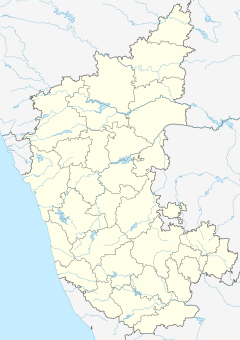เจนนเกศวเทวาลัย (เพลูรุ)
| เจนนเกศวเทวาลัย (เพลูรุ) | |
|---|---|
 เจนนเกศวเทวาลัย | |
| ศาสนา | |
| ศาสนา | ศาสนาฮินดู |
| เขต | หัสสาน |
| เทพ | พระเจนนเกศวะ (พระวิษณุ) |
| ที่ตั้ง | |
| ที่ตั้ง | เพลูรุ |
| รัฐ | รัฐกรณาฏกะ |
| ประเทศ | ประเทศอินเดีย |
| พิกัดภูมิศาสตร์ | 13°09′47″N 75°51′38″E / 13.162930°N 75.860593°E |
| สถาปัตยกรรม | |
| ประเภท | โหยสฬะ |
| ผู้สร้าง | โหยสฬะ วิษณุวรรธนะ |
| เสร็จสมบูรณ์ | ศตวรรษที่ 12 |
| เว็บไซต์ | |
| Sri Chennakeshava Temple | |
เจนนเกศวเทวาลัย (กันนาดา: ಚೆನ್ನಕೇಶವ ದೇವಾಲಯ; Chennakeshava Temple) หรือ วิชัยนารายณเทวาลัย (อังกฤษ: Vijayanarayana Temple) เป็นโบสถ์พราหมณ์ที่สร้างขึ้นในศตวรรษที่ 12 ตั้งอยู่ในเพลูรุ รัฐกรณาฏกะ ประเทศอินเดีย สร้างขึ้นโดยดำริของกษัตริย์วิษณุวรรธนะในปี ค.ศ. 1117 บนฝั่งแม่น้ำยคจี ในเพลูรุซึ่งในเวลานั้นเป็นราชธานีแห่งโหยสฬะ การก่อสร้างเทวาลัยใช้เวลา 103 ปีจนแล้วเสร็จ[1] และถูกบุกเข้าโจมตีและทำลายหลายครั้งจากสงครามตลอดประวัติศาสตร์ และมีการสร้างขึ้นใหม่อยู่เรื่อยมา เทวาลัยตั้งอยู่ห่างไป 35 กิโลเมตรจากนครหัสสาน และ ราว 220 กิโลเมตรจากเบงกาลูรุ[2]
เทวาลัยนี้สร้างขึ้นบูชาพระเจนนเกศวะ (แปลว่า "เกศวะรูปหล่อ") เป็นปางหนึ่งของพระวิษณุ เทพเจ้าในศาสนาฮินดู มาตั้งแต่แรกเริ่ม ปรากฏการกล่าวถึงในฐานะปูชนียสถานในเอกสารฮินดูยุคกลาง และยังคงสถานะเป็นปูชนียสถานสำคัญหนึ่งของลัทธิไวษณวะจนถึงปัจจุบัน[1][3] เทวาลัยนี้โดดเด่นเป็นพิเศษจากสถาปัตยกรรม, ประติมากรรม, งานสลักนูนต่ำ, หน้าบันต่าง ๆ ไปจนถึงประติมานวิทยา จารึก และประวัติศาสตร์ งานศิลปะที่ปรากฏในเทวาลัยยังแสดงวิถีชีวิตฆราวาสในสมัยศตวรรษที่ 12, ภาพของนักดนตรีและนางระบำ ไปจนถึงภาพที่เล่าประกอบเรื่องราวในคัมภีร์ฮินดู เช่น รามายณะ มหาภารตะ และปุราณะ[1][4][5] เทวาลัยลัทธิไวษณวะแห่งนี้ยังแสดงลักษณะประติมานวิทยาของลัทธิไศวะ และ ลัทธิศักติ ไปจนถึงภาพของชินะในศาสนาไชนะ และพระพุทธเจ้าในศาสนาพุทธ เทวาลัยแห่งนี้จึงถือได้ว่าเป็นหลักฐานชิ้นเอกของแง่มุมทางศิลปะ วัฒนธรรม และเทววิทยาของอินเดียใต้ในศตวรรษที่ 12 และการปกครองของจักรวรรดิโหยสฬะ[5][6]
อ้างอิง
[แก้]- ↑ 1.0 1.1 1.2 Permanent Delegation of India to UNESCO (2014), Sacred Ensembles of the Hoysala, UNESCO
- ↑ อ้างอิงผิดพลาด: ป้ายระบุ
<ref>ไม่ถูกต้อง ไม่มีการกำหนดข้อความสำหรับอ้างอิงชื่อSubramanian - ↑ Gerard Foekema 1996, pp. 47–49.
- ↑ Kirsti Evans 1997, pp. 9–10.
- ↑ 5.0 5.1 Narasimhacharya 1987, pp. 2–9.
- ↑ Winifred Holmes (1938). C.P. Snow (บ.ก.). Discovery: Mysore's Medieval Sculpture. Cambridge University Press. p. 85.
บรรณานุกรม
[แก้]- Prasanna Kumar Acharya (2010). An encyclopaedia of Hindu architecture. Oxford University Press (Republished by Motilal Banarsidass). ISBN 978-81-7536-534-6.
- Prasanna Kumar Acharya (1997). A Dictionary of Hindu Architecture: Treating of Sanskrit Architectural Terms with Illustrative Quotations. Oxford University Press (Reprinted in 1997 by Motilal Banarsidass). ISBN 978-81-7536-113-3.
- Vinayak Bharne; Krupali Krusche (2014). Rediscovering the Hindu Temple: The Sacred Architecture and Urbanism of India. Cambridge Scholars Publishing. ISBN 978-1-4438-6734-4.
- Alice Boner (1990). Principles of Composition in Hindu Sculpture: Cave Temple Period. Motilal Banarsidass. ISBN 978-81-208-0705-1.
- Alice Boner; Sadāśiva Rath Śarmā (2005). Silpa Prakasa. Brill Academic (Reprinted by Motilal Banarsidass). ISBN 978-8120820524.
- A.K. Coomaraswamy; Michael W. Meister (1995). Essays in Architectural Theory. Indira Gandhi National Centre for the Arts. ISBN 978-0-19-563805-9.
- Dehejia, V. (1997). Indian Art. Phaidon: London. ISBN 0-7148-3496-3.
- Adam Hardy (1995). Indian Temple Architecture: Form and Transformation. Abhinav Publications. ISBN 978-81-7017-312-0.
- Adam Hardy (2007). The Temple Architecture of India. Wiley. ISBN 978-0470028278.
- Adam Hardy (2015). Theory and Practice of Temple Architecture in Medieval India: Bhoja's Samarāṅgaṇasūtradhāra and the Bhojpur Line Drawings. Indira Gandhi National Centre for the Arts. ISBN 978-93-81406-41-0.
- Harle, J.C., The Art and Architecture of the Indian Subcontinent, 2nd edn. 1994, Yale University Press Pelican History of Art, ISBN 0300062176
- Monica Juneja (2001). Architecture in Medieval India: Forms, Contexts, Histories. Orient Blackswan. ISBN 978-8178242286.
- Stella Kramrisch (1976). The Hindu Temple Volume 1. Motilal Banarsidass (Reprinted 1946 Princeton University Press). ISBN 978-81-208-0223-0.
- Stella Kramrisch (1979). The Hindu Temple Volume 2. Motilal Banarsidass (Reprinted 1946 Princeton University Press). ISBN 978-81-208-0224-7.
- Kamath, Suryanath U:A Concise History of Karnataka from pre-historic times to the present, 2001, Jupiter books, MCC, Bangalore (Reprinted 2002) OCLC: 7796041.
- Gerard Foekema (1996). A Complete Guide to Hoysaḷa Temples. Abhinav Publications. ISBN 978-81-7017-345-8.
- Sastri, Nilakanta K.A.: A History of South India, From Prehistoric times to fall of Vijayanagar, 1955, OUP, New Delhi (Reprinted 2002), ISBN 0-19-560686-8
- Kirsti Evans (1997). Epic Narratives in the Hoysaḷa Temples: The Rāmāyaṇa, Mahābhārata, and Bhāgavata Purāṇa in Haḷebīd, Belūr, and Amṛtapura. BRILL. ISBN 90-04-10575-1.
- Hardy, Adam (1995) [1995]. Indian Temple Architecture: Form and Transformation-The Karnata Dravida Tradition 7th to 13th Centuries. Abhinav Publications. ISBN 81-7017-312-4.
- Krishna, M.H. (1931). History of the Kesava temple. Mysore Archaeological Department, University of Mysore.
- Krishna, M.H. (1937). A Guide to Belur. Government of Mysore Press. OCLC 995456.
- M.H. Krishna (1966). K.A. Nilakanta Sastri (บ.ก.). The history of the Sri Vijayanarayana Temple of Belur (Mysore State). The Bhandarkar Oriental Research Institute.
- Michael W. Meister; Madhusudan Dhaky (1986). Encyclopaedia of Indian temple architecture. American Institute of Indian Studies. ISBN 978-0-8122-7992-4.
- George Michell (1988). The Hindu Temple: An Introduction to Its Meaning and Forms. University of Chicago Press. ISBN 978-0-226-53230-1.
- George Michell (2000). Hindu Art and Architecture. Thames & Hudson. ISBN 978-0-500-20337-8.
- Narasimhacharya, Ramanujapuram (1987). The Kesava Temple at Belur. Asiatic Society. OCLC 37520409.
- T. A. Gopinatha Rao (1993). Elements of Hindu iconography. Motilal Banarsidass. ISBN 978-81-208-0878-2.
- Ajay J. Sinha (2000). Imagining Architects: Creativity in the Religious Monuments of India. University of Delaware Press. ISBN 978-0-87413-684-5.
- Burton Stein (1978). South Indian Temples. Vikas. ISBN 978-0706904499.
- Burton Stein (1989). The New Cambridge History of India: Vijayanagara. Cambridge University Press. ISBN 978-0-521-26693-2.
- Burton Stein; David Arnold (2010). A History of India. John Wiley & Sons. ISBN 978-1-4443-2351-1.
- Kapila Vatsyayan (1997). The Square and the Circle of the Indian Arts. Abhinav Publications. ISBN 978-81-7017-362-5.



